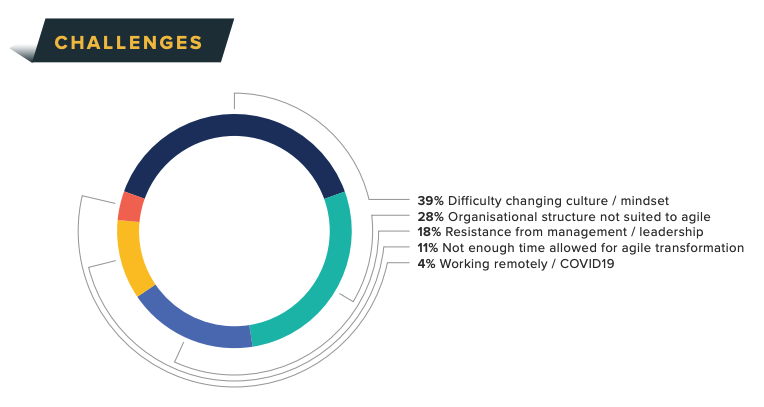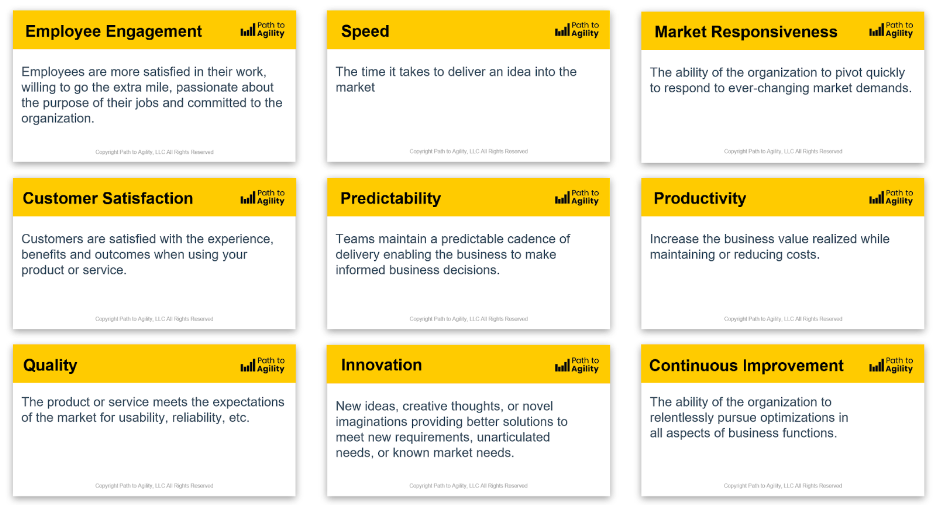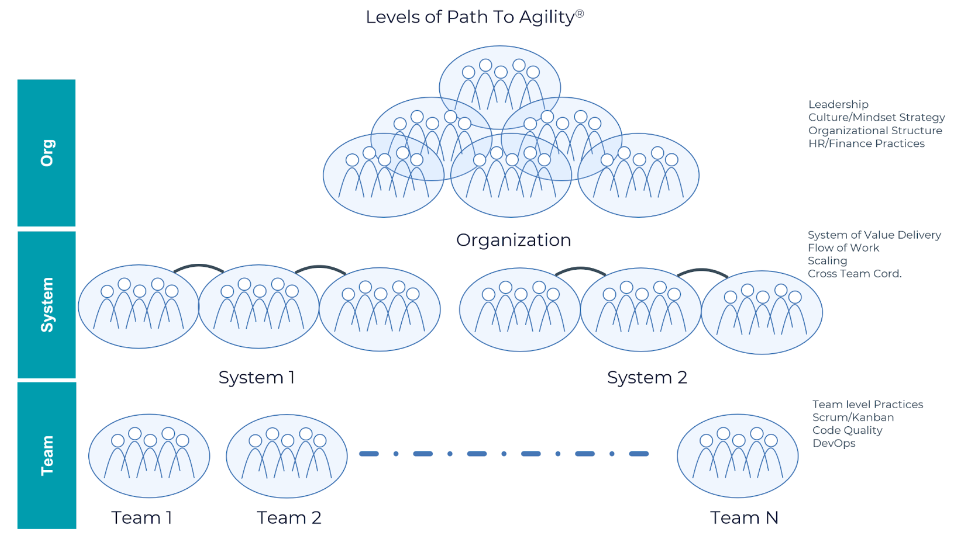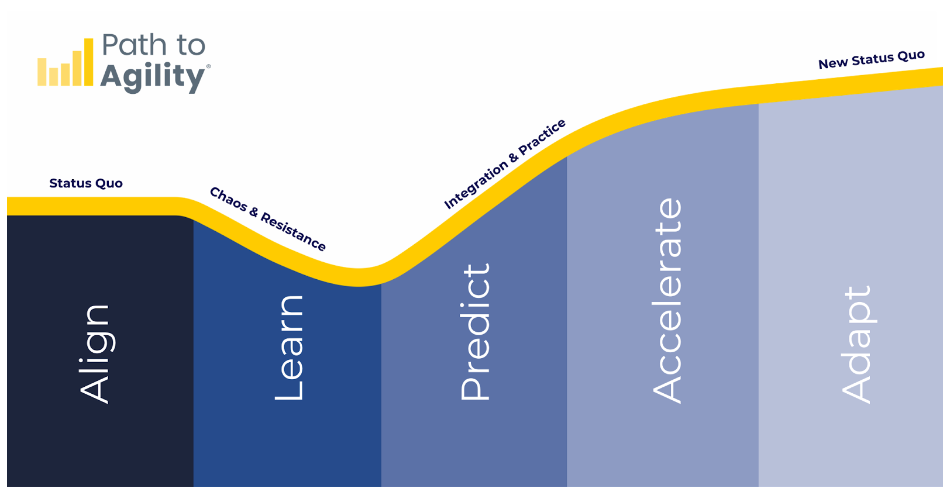Learn about purchasing for teams
Top-Down Agility: Tips for Coaches to Help Business Leaders in Agile Transformations

The 2022 State of Agile Coaching Report listed some of the top challenges faced by agile coaches. Among the challenges cited were:
- Difficulty changing mindset and culture
- Resistance from leadership
- Organizational structures not suited to agile
Here is the graph from the report showing those challenges:

As you’ll see, all of these challenges are interconnected and somewhat beg the question: What do agile coaches need to do to help organizations and leadership through an agile transformation? Ultimately, it’s on us to contend with these challenges. Agile coaches must be ready to support leaders as they shift their mindsets and see that they need to model agile behaviors for their teams.
Learn more:
- How Can Coaches Shift the Culture of an Organization?
- What Do You Do When Leadership Resists Transformation?
- There's More to the Story Than Resistance
- Strategies for Coaching Executives and Leadership
- When It Seems Like the Organization Isn't Agile-Compatible
- The Bottom Line: Show Leadership the Journey
How Can Coaches Shift the Culture of an Organization?
First, you don't change culture directly. There are a lot of coaches who will complain that agile doesn’t fit the culture. But culture is really a result of the behaviors we exhibit as an entire organization. We can't just say that we're going to come in and change the culture. We have to figure out what behaviors we need to shift to influence it.
On top of that, the people of the organization will reflect the behaviors of leadership. So if we're saying we want to change the culture, that really starts with figuring out what behavior leadership's going to need to change in themselves. You can't just say, "Hey, we're going to change things at the team level." That's one of the biggest challenges, a lot of times people just simply say, "I want to do agile. So can you apply scrum to my teams?" But the reality is, if leadership doesn't shift, the culture is not going to shift.
What Do You Do When Leadership Resists Transformation?
Another challenge reported by agile coaches is that leadership doesn’t think they need to change. So as coaches, what do we do about this?
Most of the time when a leader calls us, it can feel like they think they're calling an agile hotline: "I need help. I want to move toward agile ways of working. Can you train my teams?"
There are two problems with that statement. First, they think it's only a team-level problem. And second, they think that a one-time training session will solve all their problems. How do we get leaders involved in a culture-wide agile shift? And how do agile coaches and scrum masters help them see that the transformation is a journey and that it's not just a one-time event?
Part of the issue is that a leader may think, "Well, I have smart people working for me. Can't you just give them all the new terminology? They're smart; they'll figure it out." In reality, there's so much more that goes into having a growth mindset. One of the challenges with agile is there is no one-size-fits-all solution. We can't just have a defined prescription and then everybody applies it the same way. One of the beauties of agile is its flexibility. How you apply it to one team might be a little different from how you apply it on another team.
Scrum is a framework, not a full methodology. It doesn't have all the answers. It's not a full process. It's a skeleton that you have to flesh out. And that's what makes it really simple, but also difficult. There isn't a prescribed way of doing scrum and most of these organizations are coming from a world where work management was prescribed. They did everything one way and it was all documented. So it’s understandable that many people in leadership may be wondering, "Why can't you just come in and document the new process and the new way of working, and we'll just follow it?" We must help them see that it’s an entire mindset shift.
That's one of the places where resistance comes from… Leadership doesn't fully comprehend what is different or what it's going to take to undergo an agile transformation.
There’s More to the Story Than Resistance
Executives don't resist for no reason; they're not resistant to the outcome or the promise of agile. They want all the benefits agile promises– to be faster, more productive, and more responsive to the market.
They resist when a coach comes in and tells them they're not doing things right and that the coach knows a better way. They resist what I would call “us doing agile to them.”
All of these leaders are successful. They're executives for a reason. They didn't get to where they are without being smart. They've been successful in their career, otherwise, they wouldn't have gotten promoted. We have a dynamic where most of the coaches haven't actually been in their shoes. Executives may react with the feeling of, “who are we to tell them they're doing it wrong?” The leaders may at first not understand how we can support them. What coaches need to do is help leaders see the system of work with an alternative lens.
Real-World Example:
I remember a leader resisting when I told him that his development teams could have the potential to double their productivity. I had seen it before. I had seen teams increase their productivity by 200-300%.
When I first told him, he didn’t believe it. He asked, "Are you telling me that these teams that are already working eight hours a day are going to get 16 hours of work done in an eight-hour day?" That's what he was interpreting from what I said. When I said they could double productivity, he was thinking they're going to double their output, therefore, they're going to double their time.
He thought it was impossible. He had already tried all the things he knew to make them faster. Think of being in his shoes. He's thinking, "Who is this guy in front of me telling me I can double the productivity of my teams? I'm the leader here, I’ve already tried to optimize these teams.This guy is telling me that these teams can do twice as much. If there were a way I would have thought of it."
I explained that we are not going to realize the productivity gain by working the same way. It's not that we're going to get 16 hours of work done in an eight-hour day. One of the ways that we're going to gain productivity is by reducing wasteful activities that are happening in that eight-hour day. Creating cross-functional teams will reduce handoffs and dependencies. If we have stronger product ownership roles, we'll create focus and clarity for the teams. If we have shorter feedback loops, we'll reduce re-work that the teams are doing. If we automate testing, we will reduce redundant tasks that people are doing when they run the same test manually over and over again. By helping him see the problem differently and offering potential solutions to try it exposed him to the possible gains.
At the end of the day, agile coaches must help executives make different decisions, but it's still going to be their decision to make; they're not going to hand over the keys and say, "Coach, you drive, you make all the decisions from now on." We've got to help them see the problem from a different angle so that they can make informed choices for their teams and organization.
Strategies for Coaching Executives and Leadership
So what are strategies that an agile coach can take to support the C-suite through agile change?
#1: Change the conversation with leadership from "agile things" to making it about business outcomes.
One of the things in Path to Agility we talk about are nine business outcomes. These are things that we can have a conversation with the C-suite about that aren't agile-speak. It's not about scrum; it's not about short feedback loops; It's not about User Stories, or scrum masters, or any of that kind of stuff. It's really about what would the CEO say? The CEO is never going to say "I want to do agile," or "I want to do scrum," or "I want to limit WIP." They're unlikely to use those terms. Because they don't really care, nor should they.

What they will say is:
- "We need to increase our customer satisfaction"
- "We need to be more innovative”
- "We need to be more responsive to the market"
- "We need to be more predictable so we can make informed business decisions"
- "We need better quality"
We've got to change the conversation to business outcomes; speak their language and identify the pain points from their lens. What is it that they're struggling with that's keeping them from doing something in the market.
#2: Show them how the impact is multi-dimensional.
We look at things from three levels. Often leaders think the way to “go agile” is just to train their teams. While team level change is critical, we also need to think about the system of teams and the organizational level.

This is one of the visuals that we use to help change leaders understand the different dimensions of an agile transformation. At the team level we're talking about scrum and scrum-level practices.
We also need to think about the system of teams. When we talk about the System we are talking about the system of work and optimizing the flow of value delivery through the whole system of teams.
At an organizational level, that's where culture, mindset, leadership strategy, HR practices, and finance practices all come into play. As we start to explain this to leadership, we help them understand the scrum level is just one level we've got to address. The leaders also have a role to play in this transformation.
It's not just a team-level shift needing to happen, but also shifts need to happen at the system and organizational levels. It takes more than just team-level change to transform the organization.
There are also things they need to think about such as, what are the career paths that are going to be impacted? All of a sudden, we're creating these new roles like scrum master and product owner. We're taking people from their old role and telling them to learn these new roles. We need to have career architecture: “You're in this role and moving to scrum master - what is your career growth?” That's when we start bringing HR into helping with this transformation.
When It Seems Like the Organization Isn’t Agile-Compatible
The State of Agile Coaching Report also says that a top challenge faced by agile coaches is that the organizational structure is not suited to agility.
The issue here is that most organizations are, what I would call, locally optimized for efficiency. They have sub-functions like backend development, frontend development, quality assurance, database management, etc. They're optimized by skill set. There's usually a manager of backend,a manager of front-end, and a manager of quality assurance. They're all trying to optimize their specific group.
Real-World Example:
I can remember a time when I was the head of development, and one of my good friends was the head of quality assurance. He and I were very much aligned, we took the same approach when we laid out the strategy of the technical organization. He went and took the strategy to his QA team, and I took it to my development team.
We thought we were in lockstep in rolling out the strategy, but what ended up happening was the development team built a particular solution and the QA team built a different solution. And those solutions were totally independent from each other. They were solving similar, if not the same problems, but we ended up with two solutions that neither side of the organization could use, as opposed to building one common solution.
That's one of the things that structures of the organization can create, a divide. What we learned from that experience was that we should have brought both teams together to roll out the strategy as opposed to him rolling it out in his staff meeting, and me rolling it out in my staff meeting, and the implementations being separate. We should have communicated one message to the whole org together and given them a shared goal.
Transforming Work
Most organizations are not optimized for agile as they were designed for a different way of working. Often organizations are not designed to maximize the flow of value delivery through the system of teams.
There are inherent challenges. If you start thinking about the challenge of changing the organizational structure, we're blowing up fiefdoms. You've got a manager of backend developers whose whole identity is "I manage the backend developers." Now all of a sudden we're saying you no longer get to manage backend developers because we're going to create a cross-functional team. That is going to produce a ton of resistance because now the manager feels like they're losing their job. Changing structure and blowing up fiefdoms requires executive-level support to lead management and others through the transformation.
One of the keys to changing the structure is a clear motivation to create a better organization: i.e. Do we have clear urgency to change? Why are we changing it? If the goal is just to do agile, or to implement scrum, you're never going to persevere. We've got to have clear urgency and purpose to change that motivates action at all levels. One of the best ways to do this is to visualize the full flow of work through the system. Identify all the steps and capture where the bottlenecks are. This helps leaders see more than just their own siloed view. Only then can the leadership team partner with agile coaches to design a new flow and structure to optimize the whole.
The Bottom Line: Show Leadership the Journey
In the Path to Agility transformation approach, we talk about the journey that someone is on and we help them see that there are several stages to this transformation. There's the alignment around why; there's establishing a learning and continuous improvement culture; getting more predictable; starting to optimize for speed, and then getting more adaptable. The business outcome they choose in part determines where they're trying to go and we've got to help the leader see the journey.

As coaches we understand the journey, however the leaders have not experienced before and therefore under estimate the effort involved. Coaches need to make the journey clear. We need to arm executives with the ability to navigate the change process.
As coaches, we should measure our success by how quickly we work ourselves out of a job, which means we need to enable these leaders to be able to lead their own change journey.
We need to help leaders see the problem through a different lens. If we can arm them with a systems view, the keys to organizational change and possible solutions, then they're going to start making better decisions in support of agility. But if all we're doing is training teams and telling leadership that they’re making the wrong decisions, then we will not see success and will likely continue to encounter resistance to our transformative work.
–
Sign up below to download the 2022 State of Agile Coaching Report.










